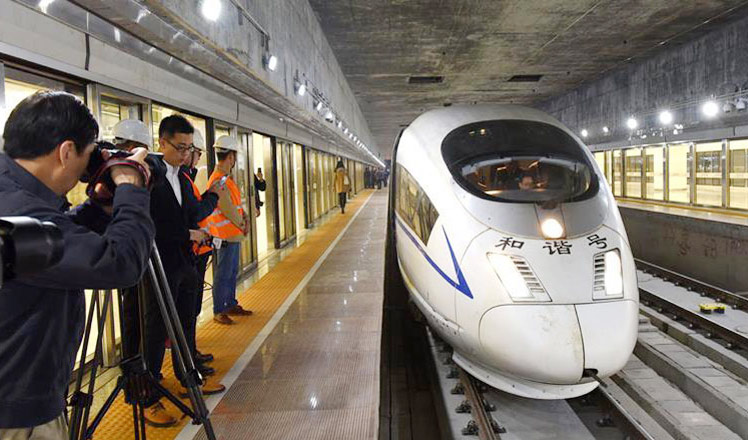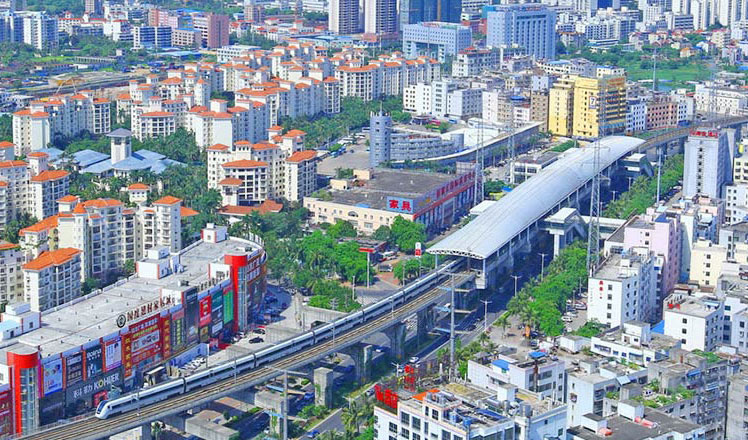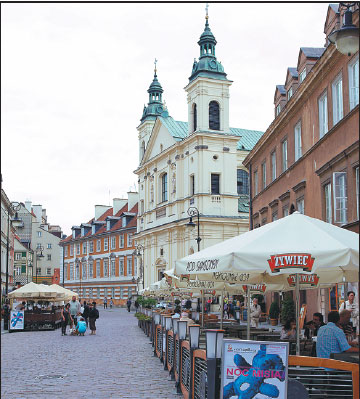Poland: History's crossroads recast as tourist hot spot
Updated: 2016-01-01 07:28
By Chen Yingqun In Poland(China Daily)
|
||||||||
Poland is somewhat new destination for Chinese tourists, compared with France, which gets about 2 million Chinese visitors a year. But Poland, which goes back to the arrival of Slavs in the area more than 1,000 years ago, is a vibrant land full of history and culture.
Poland is a crossroads in Europe, a place shaped by and sometimes caught between powerful rival forces. It is a dynamic land, where the pace often is quick and restaurants and bars frequently are surrounded by a merry, noisy atmosphere. It is an industrious place, where GDP growth runs about 3 to 4 percent, which is relatively strong for Western countries.
There are 14 UNESCO sites across the country, which is a multicultural nation with a variety of customs, traditions and historical monuments corresponding to different groups and regions.
The capital city, Warsaw, is a must-see place, an important business center with sophisticated nightlife and elegant dining. Heading into the city from the airport, you first see Soviet-style architecture built after World War II, with the most famous being Warsaw's Stalinist-style Palace of Culture and Science, also the highest building in Poland at 231 meters, including a soaring spire.
The best-known tourist attraction in the city is Warsaw Old Town, originally established in the 13th century. Its heart is the Old Town Market Place, filled with restaurants, cafes and shops. The area's medieval-style architecture sets the tone, including city walls, the Barbican - one of the few remaining parts of a complex of fortifications around the city - and St. John's Cathedral.
During WWII, more than 85 percent of Warsaw Old Town was destroyed. After the war, the area was rebuilt over five years, based on maps, pictures and paintings from before the war. The rebuilt area is listed as a UNESCO site as an important example of world architectural history from the 13th to the 20th century.
In Warsaw, you may pick up on the echoes of Romantic-era composer and pianist Frederic Chopin in the Church of the Holy Cross, where his heart, preserved in liquor, is enshrined in a column. Chopin was born near Warsaw and grew up in the city. You may also learn about the life of one of the world's greatest scientists, Madame Curie, a Warsaw native who conducted pioneering experiments on radiation. A trip to beautiful Warsaw University is also worth the time.
With Germany on the west, and Russia on the east, Poland has had a turbulent history, which you can trace through historic, religious, industrial and architectural monuments and relics. The country has been occupied and torn apart many times in its history. Polish museums are fascinating, and present historical materials using modern technology. The Warsaw Uprising Museum tells the story of the brave resistance to the Nazis by Jewish residents of the Warsaw Ghetto.
Some of the most famous handicrafts in Poland are works of amber, which is fossilized tree resin, produced mainly in Gdansk, a deepwater port city in the north of Poland on the Baltic Sea. Gdansk has striking sea views, and there are a series of ancient buildings, mainly in Gothic and Renaissance styles. Amber shops with intricate works of art line the street in Old Town.
About one hour's drive from Gdansk lies Malbork Castle, a classic example of a medieval fortress. The castle was built by the Teutonic Knights, an order of crusaders, after the conquest of pagan Old Prussia in the 13th century. It was completed in 1406 and, at the time, was the world's largest brick castle.
The castle served as one of the residences of Polish kings until the Partition of Poland in 1772, and was designated a UNESCO World Heritage Site in 1997.
Malbork, a particularly fine example of a medieval brick castle, fell into decay, but was meticulously restored in the 19th and early 20th centuries. After suffering severe damage in WWII, it was once again restored, using the detailed documentation prepared by earlier conservators.
Malbork Castle is the most complete and elaborate example of a Gothic brick castle complex built in the distinctive style of the Teutonic Order, a style that developed independently of the contemporary castles of Western Europe and the Near East.
The castle consists of three separate castles - the High, Middle and Lower Castles - separated by multiple dry moats and towers, and once housed approximately 3,000 knights.
The castle is also strategically positioned by the River Nogat, which gives it a breathtakingly picturesque appearance.
But according to our guide and interpreter Piotr Karpinski, one of Poland's best areas is the ancient city of Krakow, which is among those rare cities in Europe where the medieval town is still the vital heart of the modern metropolis.
Karpinski says to walk Krakow's streets is to take a journey through the ages, seeing the city through its many layers: Gothic, Renaissance, Baroque, Modernist. The city contains an impressive 6,000 historic buildings and monuments, and Krakow's Old Town is on UNESCO's World Cultural Heritage List.
The Auschwitz Memorial and Museum, preserved as a reminder of one of humankind's darkest periods, was a Nazi concentration and extermination camp where more than 1 million people were killed. Exhibits include piles of shoes, suitcases and hair from victims. The site in southern Poland is the location of the famous "Arbeit Macht Frei" ("Work will make you free") gate and has been visited by millions who think history is important to remember, Karpinski says.
chenyingqun@chinadaily.com.cn
|
Warsaw Old Town. Provided To China Daily |
(China Daily 01/01/2016 page10)
- Top planner targets 40% cut in PM2.5 for Beijing-Tianjin-Hebei cluster
- Yearender: Predictions for 2016 through 20 questions
- Asia's largest underground railway station opens in Shenzhen
- Shanghai bans drug-using actors, drivers
- Clamping down to clean up the air
- Yearender: Ten most talked-about newsmakers in 2015
- Over 1 million refugees have fled to Europe by sea in 2015: UN
- Turbulence injures multiple Air Canada passengers, diverts flight
- NASA releases stunning images of our planet from space station
- US-led air strikes kill IS leaders linked to Paris attacks
- DPRK senior party official Kim Yang Gon killed in car accident
- Former Israeli PM Olmert's jail term cut, cleared of main charge

 Yearender: China's proposals on world's biggest issues
Yearender: China's proposals on world's biggest issues
 NASA reveals entire alphabet but F in satellite images
NASA reveals entire alphabet but F in satellite images
 Yearender: Five major sporting rivalries during 2015
Yearender: Five major sporting rivalries during 2015
 China counts down to the New Year
China counts down to the New Year
 Asia's largest underground railway station opens in Shenzhen
Asia's largest underground railway station opens in Shenzhen
 Yearender: Predictions for 2016 through 20 questions
Yearender: Predictions for 2016 through 20 questions
 World's first high-speed train line circling an island opens in Hainan
World's first high-speed train line circling an island opens in Hainan
 'Internet Plus' changes people's lifestyles in China
'Internet Plus' changes people's lifestyles in China
Most Viewed
Editor's Picks

|

|

|

|

|

|
Today's Top News
Shooting rampage at US social services agency leaves 14 dead
Chinese bargain hunters are changing the retail game
Chinese president arrives in Turkey for G20 summit
Islamic State claims responsibility for Paris attacks
Obama, Netanyahu at White House seek to mend US-Israel ties
China, not Canada, is top US trade partner
Tu first Chinese to win Nobel Prize in Medicine
Huntsman says Sino-US relationship needs common goals
US Weekly

|

|









